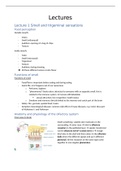College aantekeningen
Lecture Notes Principles of Sensory Science
Lecture notes of the course Principles of Sensory Science. Including the notes made during the lectures, text from the slides with corresponding images, and learning goals at the end of each lecture. Concepts and definitions in bold, showing the important concepts. Leaving a review is highly ap...
[Meer zien]




